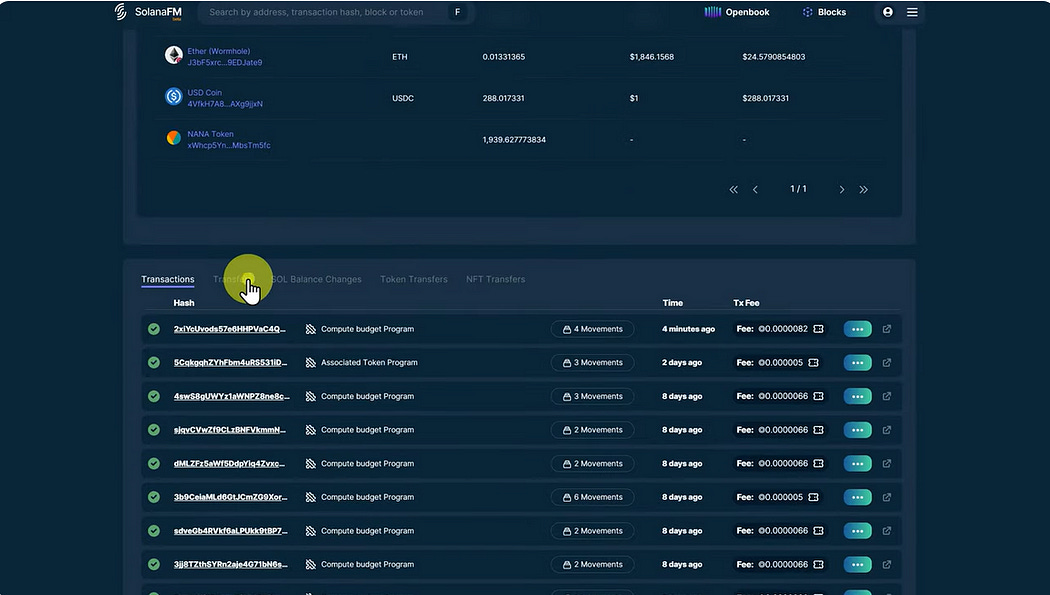How to Use Solscan & Solana Explorers (Tutorial)
Have you ever wondered what Solana Explorers are, what they do, and how to use them? If so, then you’re in the right place!
Today, we’ll explore Solana Explorers, my favourite being Solscan.io, and guide you through their effective navigation.
What Are Solana Explorers?
Solana Explorers allow you to view all the information related to your address that’s transpired on the Solana blockchain, rendering it in a human-readable format.
Explorers enable us to view the history, transactions, and everything happening on the blockchain transparently.
How to Use Solana Explorers
You first copy an address from your phantom wallet and paste it into the Solscan search bar. Here are the integral components we’re looking at:
1. Signature (Transaction ID): The first piece of data is the ‘signature’ of a transaction, also known as the ‘transaction ID’.
2. Block: The block indicates the group of transactions that the particular interaction was part of. Remember, a block on a blockchain assembles and links sets of records, thus ensuring the chain’s growth.
3. Timestamp: This shows when the transaction took place. You can convert the recorded time to your local time zone by clicking it.
4. Result: This section informs us whether the transaction was successful or not.
5. Signer: The ‘signer’ is the entity that paid the fees for the transaction. Blockchain fees are extremely negligible, practically lower than a cent.
6. Transaction Details: You can also examine the specifics of the transaction via the TX map (Transaction Map). For instance, the transfer from one wallet to another involves such details.
With these steps, you can view any transaction on the blockchain transparently using a Solana Explorer.
Exploring Different Solana Explorers
Official Solana Explorer: It is slightly hard to read but is preferred by developers due to the in-depth data it provides. (explorer.solana.com)
2. X-ray: Particularly useful if you’re dealing with compressed NFTs, although the UI might be a bit confusing for beginners. (xray.helius.xyz)
3. Solana Beach: Offers comprehensive insights on staking Solana. You can view epochs, track validators, and more. Its UI, however, isn’t the best for viewing SPL token transactions. (solanabeach.io)
4. Solana FM: Displays the price, transactions per second (TPS), true TPS, and much more detailed data. It’s slightly advanced and might be hard to navigate for beginners. (solana.fm)
Interpreting Transactions on Solana Explorer
Examining transactions using a Solana Explorer is invaluable in understanding how things work. For instance, in our sample Solana Explorer, clicking on the address opens the transaction and shows the signature, fee, and token transfer.
You’ll see a SOL balance change, which signifies the transaction fee paid from your account and another section for token balance change.
Token balance change is straightforward — it signifies the reduction of a particular token from the sender’s wallet and its increase in the receiving wallet.
However, if you notice a line item labelled ‘Rent Reserve’, it means that a small amount of Solana is paid to open the account for the first time. This Rent Reserve is refundable if you choose to close the account.
Other more complex transactions, like a swap on Jupiter or an NFT sale on Magic Eden, might require the use of different Solana Explorers to fully understand the changes. Despite the complexity, the principles remain the same, and it’s all about following the sol balance change and token balance change.
This way, you can view any transaction and keep track of your staking, token transfers, NFT purchases, and more.
The Future of Solana Explorers
While this introduction only scratches the surface of what these Explorers can do, it provides you with a good starting point.
Keep in mind that the heightened transparency these tools bring hints at a future where transactions by governments or corporations could be available for public scrutiny, fostering greater accountability.
It might sound futuristic, but with the rapid advancements in blockchain, it’s closer than you think. Remember to stay curious and don’t hesitate to experiment with these tools to better understand them.
Your curiosity is your greatest asset in mastering the blockchain.
Disclaimer: This is a helpful blog. Follow me on my socials, but remember this is NOT FINANCIAL ADVICE. I am making this content as a community member because it is great to learn crypto, playing on Solana is fun, and it is easy to onboard friends into the space with a game like this.
My opinions are my own. You can research more if you wish, and if you decide to degen, that is your decision!
Follow me on X: https://x.com/SebMontgomery












